Miniskirt
A miniskirt (sometimes hyphenated as mini-skirt, separated as mini skirt, or sometimes shortened to simply mini) is a skirt with its hemline well above the knees, generally at mid-thigh level, normally no longer than 10 cm (4 in) below the buttocks;[1] and a dress with such a hemline is called a minidress or a miniskirt dress. A micro-miniskirt or microskirt is a miniskirt with its hemline at the upper thigh, at or just below crotch or underwear level.
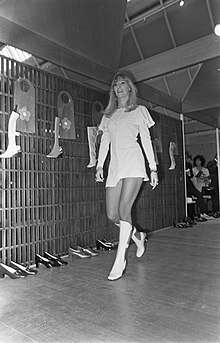
Short skirts have existed for a long time, though they were generally not called "mini" or recognised as a fashion trend until the 1960s. Instances of clothing resembling miniskirts have been identified by archaeologists and historians as far back as c. 1390–1370 BCE. In the early 20th century, the dancer Josephine Baker's banana skirt that she wore for her mid-1920s performances in the Folies Bergère was subsequently likened to a miniskirt. Extremely short skirts became a staple of 20th-century science fiction, particularly in 1940s pulp artwork, such as that by Earle K. Bergey, who depicted futuristic women in a "stereotyped combination" of metallic miniskirt, bra and boots.
Hemlines were just above the knee in 1961, and gradually climbed upward over the next few years. By 1966, some designs had the hem at the upper thigh. Stockings with suspenders (garters) were not considered practical with miniskirts and were replaced with coloured tights. The popular acceptance of miniskirts peaked in the "Swinging London" of the 1960s, and has continued to be commonplace, particularly among younger women and teenage girls. Before that time, short skirts were only seen in sport and dance clothing, such as skirts worn by female tennis players, figure skaters, cheerleaders, and dancers.
Several designers have been credited with the invention of the 1960s miniskirt, most significantly the London-based designer Mary Quant and the Parisian André Courrèges.
Pre-1960
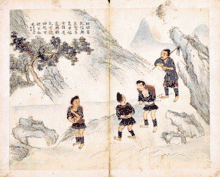
While very short skirts have existed for a long time, they were generally not called "mini" until the 1960s. Figurines produced by the Vinča culture (c. 5700–4500 BCE) have been interpreted by archaeologists as representing women in miniskirt-like garments.[2] One of the oldest surviving garments resembling a miniskirt is the short woollen skirt with bronze ornaments worn by the Egtved Girl for her burial in the Nordic Bronze Age (c. 1390–1370 BCE).[3][4]
One of the earliest known cultures where women regularly wore clothing resembling miniskirts was a subgroup of the Miao people of China, the Duan Qun Miao (Chinese: 短裙苗; pinyin: duǎn qún miáo, literally "short skirt Miao").[5] In albums produced during the Qing dynasty (1644–1912) from the early eighteenth century onwards to illustrate the various types of Miao, the Duan Qun Miao women were depicted wearing "mini skirts that barely cover the buttocks."[5] At least one of the "One Hundred Miao Pictures" albums contains a poem that specifically describes how the women's short skirts and navel-baring styles were an identifier for this particular group.[6][7]
The dancer Josephine Baker's banana skirt that she wore for her mid-1920s performances in the Folies Bergère was subsequently likened to a miniskirt.[8][9]
Mid-20th century science fiction
Extremely short skirts became a staple of 20th-century science fiction, particularly in 1940s pulp artwork such as that by Earle K. Bergey who depicted futuristic women in a "stereotyped combination" of metallic miniskirt, bra and boots.[10][11] The "sci-fi miniskirt" was seen in genre films and television programmes as well as on comic book covers.[10] The very short skirts worn by regular female characters Carol and Tonga (played by Virginia Hewitt and Nina Bara) in the 1950–55 television series Space Patrol have been suggested as probably the first 'micro-minis' to have been seen on American television.[10] It was later seen as remarkable that only one formal complaint relating to the skirts could be recalled, and that by an ad agency in relation to an upwards shot of Carol climbing a ladder.[10] Hewitt pointed out that even though the complainant claimed they could see up her skirt, her matching tights rendered her effectively clothed from neck to ankle.[10] Otherwise, Space Patrol was applauded for being wholesome and family-friendly, even though the women's short skirts would have been unacceptable in other contexts.[10] Although the 30th-century women in Space Patrol were empowered, experts in their field, and largely treated as equals, "it was the skirts that fuelled indelible memories."[12] The Space Patrol skirts were not the shortest to be broadcast at the time – the German-made American 1954 series Flash Gordon showed Dale Arden (played by Irene Champlin) in an even shorter skirt.[13]
1960s
The manager of an unnamed shop in London's Oxford Street began experimenting in 1960 with skirt hemlines an inch above the knees of window mannequins, and noted how positively his customers responded.[14] Hemlines were just above the knee in 1961, and gradually climbed upward over the next few years. By 1966, some designs had the hem at the upper thigh. Stockings with suspenders (American English: "garters") were not considered practical with miniskirts and were replaced with coloured tights.[15] Towards the end of the 1960s, an even shorter version, called the microskirt or micro-mini, emerged.[16][17]
Extremely short skirts, some as much as eight inches above the knee, were observed in Britain in the summer of 1962.[18] The young women who wore these short skirts were called "Ya-Ya girls", a term derived from "yeah, yeah" which was a popular catcall at the time.[18] One retailer noted that the fashion for layered net crinoline petticoats raised the hems of short skirts even higher.[18] The designer Mary Quant was quoted as saying that "short short skirts" indicated youthfulness which was seen as desirable, fashion-wise.[18]
The earliest known reference to the miniskirt is in a humorous 1962 article datelined Mexico City and describing the "mini-skirt" or "Ya-Ya" as a controversial item of clothing that was the latest thing on the production line there. The article characterized the miniskirt as stopping eight inches above the knee. It referred to a writing by a psychiatrist, whose name it did not provide, who had argued that the miniskirt was a youthful protest of international threats to peace. Much of the article described the reactions of men, who were said to favor the fashion on young women to whom they were unrelated, but to oppose it on their own wives and fiancés.[19]
In the UK, by shortening the skirts to less than 24 inches (610 mm) they were classed as children's garments rather than adult clothes. Children's clothing was not subject to purchase tax whereas adult clothing was.[20] The avoidance of tax meant that the price was correspondingly less.[21][22]
Designer claims
.jpg)
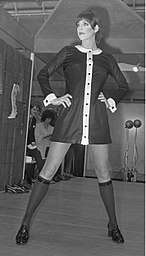
Several designers have been credited with the invention of the 1960s miniskirt, most significantly the London-based designer Mary Quant and the Parisian André Courrèges. Although Quant reportedly named the skirt after her favourite make of car, the Mini,[23][24] there is no consensus as to who designed it first. Valerie Steele has noted that the claim that Quant was first is more convincingly supported by evidence than the equivalent Courrèges claim.[25] However, the contemporary fashion journalist Marit Allen, who edited the influential "Young Ideas" pages for UK Vogue, firmly stated that the British designer John Bates was the first to offer fashionable miniskirts.[26] Other designers, including Pierre Cardin and Yves Saint Laurent, had also been raising hemlines at the same time.[27]
- Mary Quant
The miniskirt is one of the garments most widely associated with Mary Quant.[28] Quant herself is ambivalent about the claim that she invented the miniskirt, stating that her customers should take credit, as she herself wore very short skirts, and they requested even shorter hemlines for themselves.[29] Regardless of whether or not Quant invented the miniskirt, it is widely agreed that she was one of its highest-profile champions.[25][27][30] Contrary to obvious and popular belief, Quaint named the garment after the Mini Cooper, a favorite car of hers, stating that the car and the skirt were both "optimistic, exuberant, young, flirty", and complemented each other.[23][31]
Quant had started experimenting with shorter skirts in the late 1950s, when she started making her own designs up to stock her boutique on the King's Road.[29] Among her inspirations was the memory of seeing a young tap-dancer wearing a "tiny skirt over thick black tights", influencing her designs for young, active women who did not wish to resemble their mothers.[23][29] In addition to the miniskirt, Quant is often credited with inventing the coloured and patterned tights that tended to accompany the garment, although their creation is also attributed to the Spanish couturier Cristóbal Balenciaga who offered harlequin-patterned tights in 1962[32][33] or to Bates.[34]
In 2009, a Mary Quant minidress was among the 10 British "design classics" featured on a series of Royal Mail stamps, alongside the Tube map, the Spitfire, and the red telephone box.[23]
- André Courrèges
Courrèges explicitly claimed that he invented the mini, and accused Quant of only "commercialising" it.[25] He presented short skirts measuring four inches above the knee in January 1965 for that year's Spring/Summer collection,[27] although some sources claim that Courrèges had been designing miniskirts as early as 1961, the year he launched his couture house.[25] The collection, which also included trouser suits and cut-out backs and midriffs, was designed for a new type of athletic, active young woman.[27] Courrèges had presented "above-the-knee" skirts in his August 1964 haute couture presentation which was proclaimed the "best show seen so far" for that season by The New York Times.[35] The Courrèges look, featuring a knit bodystocking with a gabardine miniskirt slung around the hips, was widely copied and plagiarised, much to the designer's chagrin, and it would be 1967 before he again held a press showing for his work.[27] Steele has described Courrèges's work as a "brilliant couture version of youth fashion" whose sophistication far outshone Quant's work, although she champions the Quant claim.[25] Others, such as Jess Cartner-Morley of The Guardian explicitly credit him, rather than Quant, as the miniskirt's creator.[32]
- John Bates and others
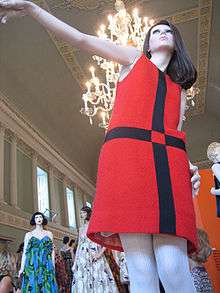
The idea that John Bates, rather than Quant or Courrèges, innovated the miniskirt had an influential champion in Marit Allen, who as editor of the influential "Young Ideas" pages for UK Vogue, kept track of up-and-coming young designers.[26] In 1966 she chose Bates to design her mini-length wedding outfit in white gabardine and silver PVC.[26] In January 1965 Bates's "skimp dress" with its "short-short skirt" was featured in Vogue, and would later be chosen as the Dress of the Year.[37][38][39] Bates was also famous for having designed mini-coats and dresses and other outfits for Emma Peel (played by Diana Rigg) in the TV series The Avengers, although the manufacturers blocked his request for patterned tights to enable Emma Peel to fight in skirts if necessary.[26][34]
An alternative origin story for the miniskirt came from Barbara Hulanicki of the London boutique Biba, who recalled that in 1966 she received a delivery of stretchy jersey skirts that had shrunk drastically in transit. Much to her surprise, the ten-inch long garments rapidly sold out.[40]
In 1967 Rudi Gernreich was among the first American designers to offer miniskirts, in the face of strongly worded censure and criticism from American couturiers James Galanos and Norman Norell.[41] Criticism of the miniskirt also came from the Paris couturier Coco Chanel, who declared the style "disgusting" despite being herself famed for supporting shorter skirts in the 1920s.[25]
Reception
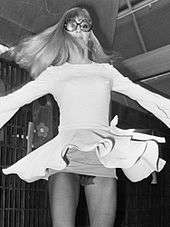
Owing to Quant's position in the heart of fashionable "Swinging London", the miniskirt was able to spread beyond a simple street fashion into a major international trend. The style came into prominence when Jean Shrimpton wore a short white shift dress, made by Colin Rolfe, on 30 October 1965 at Derby Day, first day of the annual Melbourne Cup Carnival in Australia, where it caused a sensation. According to Shrimpton, who claimed that the brevity of the skirt was due mainly to Rolfe's having insufficient material, the ensuing controversy was as much as anything to do with her having dispensed with a hat and gloves, seen as essential accessories in such a conservative society.[42][43]
Upper garments, such as rugby shirts, were sometimes adapted as mini-dresses. With the rise in hemlines, the wearing of tights or pantyhose, in place of stockings, became more common. Some European countries banned mini-skirts from being worn in public, claiming they were an invitation to rapists. In response, Quant retorted that there was clearly no understanding of the tights worn underneath.[44]
The response to the miniskirt was particularly harsh in Africa, where many state governments saw them as an un-African garment and part of the corrupting influence of the West.[45] Young city-dwelling African women who wore Western clothing such as the miniskirt were particularly at risk of attack based on their clothing, although Robert Ross notes that gender roles and politics were also a key factor.[45] The urban woman earning her own living and independence was seen as a threat to masculine authority, particularly if she wore clothing seen as un-African.[45] Short skirts were seen as indicating that their wearer was a prostitute, and by conflation, a witch who drained male-dominated society of its vitality and energy.[45] In addition to prostitute and witches, miniskirts also became associated with secretaries, schoolgirls and undergraduates, and young women with "sugar daddies" as lovers or boyfriends.[46] Andrew M. Ivaska has noted that these various tropes boiled down to a basic fear of female power, fear that a woman would use her education or sexual power to control men and/or achieve her own independence, and that the miniskirt therefore became a tangible object of these fears.[46]
In 1968 the Youth League of Tanzania's ruling TANU party launched Operation Vijana.[45] Organised and run by young men, Vijana was a morality campaign targeting indecent clothing, which led to attacks on women with at least one stoning reportedly triggered by the victim's miniskirt.[45] Gangs of youths patrolled bus stations and streets looking for women dressed "inappropriately", and dealing out physical attacks and beatings.[46] In Ethiopia, an attack on women wearing miniskirts triggered a riot of leftist students in which a hundred cars were set on fire and fifty people injured.[45]
Kamuzu Banda, president of Malawi, described miniskirts as a "diabolic fashion which must disappear from the country once and for all."[45] It is also reported that Kenneth Kaunda, president of Zambia, cited apartheid and the miniskirt as his two primary hates.[45] By the mid-1970s the Zanzibar revolutionary party had forbidden both women and men from wearing a long list of garments, hairstyles and cosmetics, including miniskirts.[45]
Post-1960s
1970s
From 1969 onwards, the fashion industry largely returned to longer skirts such as the midi and the maxi. Journalist Christopher Booker gave two reasons for this reaction: firstly, that "there was almost nowhere else to go ... the mini-skirts could go no higher"; and secondly, in his view, "dressed up in mini-skirts and shiny PVC macs, given such impersonal names as 'dolly birds', girls had been transformed into throwaway plastic objects".[47] Certainly this lengthening of hemlines coincided with the growth of the feminist movement. However, in the 1960s the mini had been regarded as a symbol of liberation, and it was worn by some, such as Germaine Greer and, in the following decade, Gloria Steinem.[48] Greer herself wrote in 1969 that:
The women kept on dancing while their long skirts crept up, and their girdles dissolved, and their nipples burst through like hyacinth tips and their clothes withered away to the mere wisps and ghosts of draperies to adorn and glorify ...[49]
Although they disappeared from mainstream fashion by the mid-70s, miniskirts never entirely went away. This was evidenced by Deborah Harry of the group Blondie, Kate Pierson and Cindy Wilson of the group The B-52's, Siouxsie Sioux of the group Siouxsie And The Banshees, and the group The Slits, who often wore miniskirts during the "new wave" era of the late 70s; and by the female cast members of the TV show Hee Haw, who were known as the "Hee Haw Honeys", who always wore country-style minidresses even during the miniskirt's fashion hiatus in the late 70s and early 80s; and as mentioned above, by female tennis players, figure skaters, cheerleaders, and dancers. The song "(I Don't Want to Go to) Chelsea" (1978), by new wave artist Elvis Costello, contained the line: "There's no place here for the mini-skirt waddle".
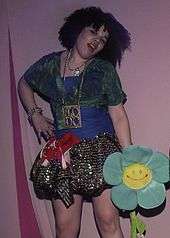
1980s and 1990s
In the spring of 1982 (as featured in the June issue of Time Magazine that year), short skirts began to re-emerge, notably in the form of "rah-rahs", which were modeled on those worn by female cheerleaders at sporting and other events. In 1985, the British designer Vivienne Westwood offered her first "mini-crini", an abbreviated version of the Victorian crinoline.[50] Its mini-length, bouffant silhouette inspired the puffball skirts widely presented by more established designers such as Christian Lacroix.[51][52] In 1989, Westwood's mini-crini was described as having combined two conflicting ideals – the crinoline, representing a "mythology of restriction and encumbrance in woman's dress", and the "equally dubious mythology of liberation" associated with the miniskirt.[53]
From the 1980s, many women began to incorporate the miniskirt into their business attire, a trend which grew during the remainder of the century. The titular character of the 1990s television program Ally McBeal, a lawyer portrayed by Calista Flockhart, has been credited with popularising micro-skirts.[54]
The very short skirt is an element of Japanese school uniform, which since the 1990s has been exploited by young women who are part of the kogal (or gyaru) subculture as part of their look.[55] Gyaru deliberately wear their skirts short enough to reveal panties (actually a second pair worn over actual knickers) as a form of exhibitionism known as panchira.[56]
2000s and 2010s
In the early 2000s, micro-minis were once again revived.[16] In 2003, Tom Ford, at that time described as one of the few designers able to effortlessly dictate changes in fashion, stated that micro-skirts would be the height of fashion for Spring/Summer 2003.[57] For fashionable wear, early 21st century microskirts were often worn with leggings or tights in order to avoid revealing too much.[54] At this time, an even briefer version of the micro-mini emerged, creating a garment sometimes described as a "belt-skirt."

A BBC article in 2014 wrote that miniskirts remained as contemporary a garment as ever, retaining their associations with youth.[23] In an early 2010s study the department store Debenhams found that women continued buying miniskirts up to the age of 40, whilst 1983 studies showed that 33 years old was when the average woman had stopped buying them.[23] Debenham's report concluded that by the 2020s, miniskirts would be seen as a wardrobe staple for British women in their 40s and early 50s.[23]
Despite this, in the early 21st century, miniskirts are still seen as controversial, and remain subject to bans and regulation.[23] Valerie Steele told the BBC in 2014 that even though miniskirts no longer had the power to shock in most Western cultures, she would hesitate to wear one in most parts of the world.[23] She described the garment as symbolic of looking forward to future freedom and backwards to a "much more restricted past." and noted that international rises in extreme conservatism and religious fundamentalism had led to an anti-women backlash, some of which was shown through censure and criticism of women wearing "immodest" clothing.[23] In 2010, the mayor of Castellammare di Stabia in Italy ordered that police fine women for wearing "very short" miniskirts.[23][58] In the 2000s, a ban on miniskirts at a teacher's college in Kemerovo was claimed by lawyers to be against the terms of equality and human rights as laid out by the Russian constitution, whilst in Chile, the women's minister, Carolina Schmidt, described a regional governor's ban on public employees wearing minis and strapless tops as "absolute nonsense" and challenged their right to regulate other people's clothing.[58] In July 2010, Southampton city council also tried to regulate their female employees's wardrobes, telling them to avoid miniskirts and dress "appropriately."[58]
Miniskirts regularly appear in Africa as part of controversies, something that has continued since the 1960s.[59] In the early 21st century alone, instances have included a proposed ban on miniskirts in Uganda justified by claiming that they were a dangerous distraction to drivers and would cause road accidents, and in 2004, a leaflet campaign in Mombasa instructed women to dress modestly and "shun miniskirts", leading to the Kenyan government denying that they wanted a ban.[58] Since the 1990s, women perceived to be "indecently dressed" might be stripped in public often by gangs of men, but sometimes by other women.[59] These acts took place in Kenya, Zambia and elsewhere, including incidents in Johannesburg in 2008 and 2011 which led to similar attacks in various states including Sudan, Malawi, Zimbabwe and elsewhere.[59] The President of Malawi, Bingu wa Mutharika, was forced to make a statement in 2012 after male gangs forcibly stripped women in Lilongwe and Mzuzu.[59] By this point, "miniskirt protests" regularly followed these acts of violence, with the protesters defiantly wearing miniskirts.[59] In late February 2010, a group of about 200 Ugandan women demonstrated against a so-called "miniskirt law", an anti-pornography legislation which specifically forbade women to dress "in a manner designed to sexually excite", or from wearing clothing that revealed their thighs and/or other body parts.[58] Uganda revisited their proposed ban in 2013, with Simon Lokodo, Minister of Ethics and Integrity, proposing another anti-pornography bill which would outlaw revealing "intimate parts", defined as "anything above the knee", and vowing that women who wore miniskirts would be arrested.[60] While most of these proposed bans come from male politicians, in 2009 Joice Mujuru, Zimbabwe's Vice President, had to deal with rumours that she intended to ban miniskirts and trousers for women.[59] In Africa, one of the main issues with the miniskirt since the 1960s is that it is seen as representative of protest against predominantly male authority, an accusation also applied to trousers for women which are perceived as blurring the gender divide.[45][46][59]
See also
References
- (in French) Sophie George, Le Vêtement de A à Z, ISBN 978-2-9530240-1-2, p.100.
- Cvekic, Ljilja (12 November 2007). "Prehistoric women had passion for fashion". Reuters. Retrieved 19 September 2016.
- A. F. Harding (18 May 2000). European Societies in the Bronze Age. Cambridge University Press. pp. 372–. ISBN 978-0-521-36729-5.
- Ghose, Tia (May 21, 2015). "Remains of Bronze-Age Cultic Priestess Hold Surprise". livescience. Retrieved 19 June 2015.
- Diamond, Norma (1997). "Defining the Miao". In Harrell, Stevan (ed.). Cultural encounters on China's ethnic frontiers (2nd pr. ed.). Seattle: University of Washington Press. pp. 98–103. ISBN 0-295-97528-8.
- Steele, Apollonia. "Chinese Language Book". University of Calgary library. Retrieved 21 October 2015.
- Unknown (pre-1911); Zhang, Jane (translator) (2002). "Duan Qun Miao (Mini-Skirt Miao)". University of Calgary Library. Retrieved 21 October 2015.
- Kline, Christina Baker (2008). Burt, Anne (ed.). About face : women write about what they see when they look in the mirror. Berkeley, CA: Seal Press. p. 60. ISBN 9781580052467.
- Adams, Michael Henry (September 2007). "How Black Style became Beautiful". Ebony: 74.
- Bassior, Jean-Noel (2005). "Stardrive: Going Network". Space patrol : missions of daring in the name of early television. Jefferson, N.C. [u.a.]: McFarland. p. 99. ISBN 9780786419111.
- Stableford, Brian (2004). Historical dictionary of science fiction literature. Lanham, Md.: Scarecrow Press. p. 77. ISBN 9780810849389.
- Bassior, Jean-Noel (2005). "Carol and Tonga: The Women of the Space Patrol". Space patrol : missions of daring in the name of early television. Jefferson, N.C. [u.a.]: McFarland. pp. 304–6. ISBN 9780786419111.
- Bassior, Jean-Noel (2005). "Blast-Off". Space patrol : missions of daring in the name of early television. Jefferson, N.C. [u.a.]: McFarland. p. 25. ISBN 9780786419111.
- Montreal Gazette, May 28, 1960, page 2
- Laver, James (2002). Costume and Fashion: A Concise History. London: Thames & Hudson, Ltd. pp. 261–2. ISBN 978-0-500-20348-4.
- Cumming, Valerie; Cunnington, C. W.; Cunnington, P. E. (2010). The dictionary of fashion history (Rev.ised, updated and supplemented ed.). Oxford: Berg. pp. 130–131. ISBN 9780857851437.
- Whiteley, Nigel (1987). Pop design : modernism to mod. London: Design Council. p. 209. ISBN 9780850721591.
- Gilmore, Eddie (12 June 1962). "British Girls (Ya! Ya!) Wear Skirts 8 Inches Above Knee". Independent (Long Beach, California). p. 22. Retrieved 16 November 2015 – via Newspapers.com.
- John Abney, "Yahoo! The Ya-Ya!" Billings Gazette, Aug. 6, 1962, p. 6.
- "premierludwig" (19 July 2005). "Trends Of The Mid-1960s workshop". Vintage Fashion Guild. Retrieved 31 January 2017.
- Livraghi, Giancarlo (2002). "The pitfalls of fashion". off-line. Retrieved 31 January 2017.
- Thomas, Pauline (2014). "The 60s Mini Skirt 1960s Fashion History". Fashion-Era.com. Retrieved 31 January 2017.
- Foreman, Katya (21 October 2014). "Short but sweet: The miniskirt". BBC. Retrieved 9 June 2016.
- Miles, Barry (2009). The British invasion: the music, the times, the era. New York, NY: Sterling. p. 203. ISBN 9781402769764.
- Steele, Valerie (2000). Fifty years of fashion : new look to now (English ed.). New Haven: Yale University Press. pp. 51–64. ISBN 9780300087383.
- "Garments worn by Marit Allen". Victoria and Albert Museum. Retrieved 12 July 2012.
- Polan, Brenda; Tredre, Roger (2009). "André Courrèges". The great fashion designers (English ed.). Oxford: Berg Publishers. pp. 123–125. ISBN 9780857851741.
- Horton, Ros; Simmons, Sally (2006). Women who changed the world : fifty inspirational women who shaped history. London: Quercus. p. 170. ISBN 9781847240262.
- Polan, Brenda; Tredre, Roger (2009). "Mary Quant". The great fashion designers (English ed.). Oxford: Berg Publishers. pp. 103–105. ISBN 9780857851741.
- Kennedy, Carol (2003). From Dynasties to Dotcoms : The Rise, Fall and Reinvention of British Business in the Past 100 Years. London: Kogan Page Ltd. p. 122. ISBN 9780749441272.
- "The stories behind five global fashion trends". BBC. 2019. Retrieved 11 October 2019.
- Cartner-Morley, Jess (2 December 2000). "Chelsea girl who instigated a new era". The Guardian. Retrieved 12 July 2012.
- Carter, Ernestine (1977). The changing world of fashion: 1900 to the present. London: Weidenfeld and Nicolson. p. 213. ISBN 9780297773498.
- Lester, Richard (2008). John Bates : fashion designer. Woodbridge, Suffolk: ACC Editions. p. 43. ISBN 9781851495702.
- Peterson, Patricia (3 August 1964). "Courrèges Is Star of Best Show Seen So Far". The New York Times. Retrieved 11 January 2016.
- Lester, Richard (2008). John Bates : fashion designer. Woodbridge, Suffolk: ACC Editions. p. 38. ISBN 9781851495702.
- Lester, Richard (2008). John Bates : fashion designer. Woodbridge, Suffolk: ACC Editions. p. 45. ISBN 9781851495702.
- Breward, Christopher; Lister, Jenny; Gilbert, David, eds. (2006). Swinging sixties : fashion in London and beyond ; 1955 – 1970. London: V&A Publ. p. 31. ISBN 9781851774845.
- "Dress of the Year walkthrough". Fashion Museum, Bath. Bath & North East Somerset Council 2015. Retrieved 21 October 2015.
- Staff writer. "Barbara Hulanicki and Biba". Victoria and Albert Museum. Retrieved 21 October 2015.
- Staff writer (1 December 1967). "Fashion: Up, Up & Away". TIME.(subscription required)
- Shrimpton, Jean (1990). An Autobiography.
- Kimball, Duncan (2002-09-12). Jean Shrimpton in Melbourne. Milesago article on Jean Shrimpton also known as jean shrimpTON, modified "Thursday, 12 September 2002 10:48:55". Retrieved from http://www.milesago.com/Features/shrimpton.htm.
- Adburgham, Alison (1967-10-10). Mary Quant. Interview with Alison Adburgham, The Guardian, 10 October 1967. Retrieved from http://century.guardian.co.uk/1960-1969/Story/0,6051,106475,00.html.
- Ross, Robert (2008). "Engendered Acceptance and Rejection". Clothing: A Global History. Polity. pp. 162–163. ISBN 9780745631868.
- Ivaska, Andrew M. "'Anti-mini Militants Meet Modern Misses': Urban Style, Gender, and the Politics of 'National Culture' in 1960s Dar es Salaam, Tanzania". In Allman, Jean (ed.). Fashioning Africa: Power and the Politics of Dress. Indiana University Press. pp. 113–114. ISBN 0253111048.
- Christopher Booker (1980) The Seventies
- Holt, Patricia (22 September 1995). "Making Ms.Story / The biography of Gloria Steinem, a woman of controversy and contradictions". The San Francisco Chronicle.
- Greer, Germaine (1969-02). Germaine Greer in Oz, February 1969.
- Staff writer. "Vivienne Westwood designs". Victoria and Albert Museum. Retrieved 5 June 2015.
- Cicolini, Alice; British Council (2000). Inside out: underwear and style in the UK. Black Dog.
- Evans, Caroline (2004). "Cultural Capital 1976–2000". In Breward, Christopher; Ehrman, Edwina; Evans, Caroline (eds.). The London look : fashion from street to catwalk. New Haven: Yale University Press / Museum of London. p. 149. ISBN 9780300103991.
- Evans, Caroline; Thornton, Minna (1989). Women and Fashion: A New Look. London: Quartet Books. pp. 148–150. ISBN 9780704326910.
- Standring, Chris (2 March 2015). "Top Trends: Spring's long skirts flatter every body". Edmonton Journal. Postmedia Network Inc. Retrieved 20 October 2015.
- Parry, Richard Lloyd (22 October 2011). "Japan's schoolgirls set the trend". The Independent. Retrieved 26 October 2015.
- Miller, Laura (2012). "Youth fashion and beautification". In Mathews, Gordon; White, Bruce (eds.). Japan's Changing Generations: Are Young People Creating a New Society?. Routledge. pp. 87–88. ISBN 9781134353897.
- Staff writer (29 September 2002). "Gucci Spring/Summer 2003 Ready-To-Wear". Vogue. Condé Nast. Archived from the original on 27 November 2015. Retrieved 20 October 2015.
- Jones, Sam; Kington, Tom (25 October 2010). "Italian mayor seeks ban on miniskirts that reveal too much". The Guardian. Retrieved 9 June 2016.
- Kiruga, Morris (5 December 2014). "Understanding Africa's 'fashion gestapo': Miniskirts, maxi skirts make-up and long beards". Mail and Guardian Africa. Retrieved 10 June 2016.
- Sevenzo, Farai (2 May 2013). "Letter from Africa: Miniskirts and morals". BBC News. Retrieved 10 June 2016.
- Sources
- Quant, Mary (1996). Quant by Quant. London: Cassell.
External links
| Wikimedia Commons has media related to: |
.png)
